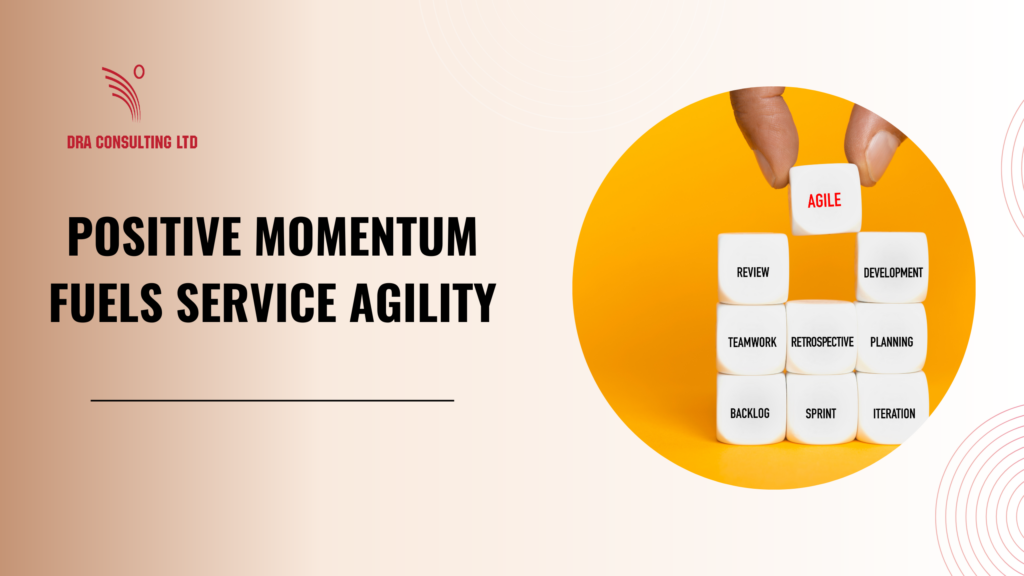If a business does not experience positive momentum, it’s going nowhere, basically. Momentum gives the thrust that enables a business to accelerate its strategic direction, its goals and ultimately, its results. “Are we achieving progress and more so, sustaining momentum?” This is one of the key questions that preoccupies the minds and discussions in the boardrooms at top tier businesses. May I suggest that it may be profitable to have it become a viral question?
When positive momentum takes the lead in a business, service delivery converts into service agility. Service agility is the persistent ability of a business to improve and evolve its various ways of keeping customers happy. The single outstanding feature of service agility lies in its accelerated responsiveness to changing customer circumstances and needs.
Momentum gives the thrust that enables a business to accelerate its strategic direction, its goals and ultimately, its results.
When customer sensors of a business detect the need to respond to a shift in service and subsequently, the business executes a deliberate response that is well timed and perfectly suited to the challenge, that’s an example of service responsiveness. Of course, if a business lacks customer sensors, or fails to pay attention to those that exist, the service delivery machinery and therefore, the customer experience, may implode.
If the pattern of responding deliberately and effectively to change triggers keeps up, momentum is sustained and the landing gear becomes service agility. The root of service agility lies in the existence of generalized momentum across the business.
When positive momentum takes the lead in a business, service delivery converts into service agility.
A good starting point to propel generalized momentum across a business, is to conduct monthly reviews of its overarching strategic plan. As I mentioned in an earlier article, I’ve encountered so many businesses that only revisit their plans annually. Not a good idea. For the record, three contributors to the failure of strategic plans include poorly stated strategies, infrequent tracking and lack of agility in adjusting the plan to respond to changed business circumstances. Strategic plans should be tracked and course-corrected on a monthly basis, if they are to achieve the mission for which they are designed.
Sustained remediation of any malfunctioning or faulty areas of a business delivers an immediate improvement in the health of a business and drives positive momentum. Some business leaders pick and choose internal battles based on their emotions, ignorance, apathy or skill insufficiency, instead of on priorities or urgent matters. Often, the outcome is a worsening of the situation, which in turn, sacrifices momentum.
Service agility is the persistent ability of a business to improve and evolve its various ways of keeping customers happy.
From where I sit, it’s so much better to fix or remediate problems that obstruct progress, rather than stare at them becoming progressively worse, even as they create a whole downstream assemblage of constraints to business velocity.
Cultural agility exerts one of the greatest influences over business momentum. If a business has the ambition to become culturally agile, my suggestion as a transformation consultant, would be for that business to aim firstly, to engender a growth culture. When a culture of growth becomes normalized over time, cultural agility is the ultimate payoff.
The root of service agility lies in the existence of generalized momentum across the business.
A growth culture attracts employee enrichment, aims at eradicating incivility, focuses on internal harmony and the expulsion of non-viable interpersonal practices. In fact, when the alchemy of these moving parts is perfected, the environment becomes so unburdened, that the runway for achieving profitability becomes unobstructed.
Whilst high-performance cultures are wired to produce profitable returns, a growth culture is more likely to create a stock of all-round good practices that energize goodwill amongst the employee, customer and stakeholder populations.
A good starting point to propel generalized momentum across a business, is to conduct monthly reviews of its overarching strategic plan.
As I mentioned earlier, there’s a big winner when a business begins to achieve positive momentum. Service agility.
In the service delivery universe, the average business generates intermittent sparks of customer experience happiness over its lifetime. The businesses that distinguish themselves however, are those that are obsessed with increasing the rapidity and brilliance associated with keeping their customers happy. Their sights are set on being agile and building momentum in an evolving marketplace.
Achieving positive momentum is not a walk in the park for a business. There’s the balancing act of managing the convulsions associated with competing forces within the business, whilst trying to win at the race for capturing and keeping customers’ attention, amidst the noise of competitive offerings.
Positive momentum cannot succeed without the existence of momentum leaders. These are leaders who are up for the challenge of navigating internal and external forces, with a clear mission in mind. Agility in decision-making and execution.
Momentum leaders are agile leaders who are different to their less agile counterparts in one major way.
Their willingness to shape the future, when the future is mercurial, crowded and ambiguous.

